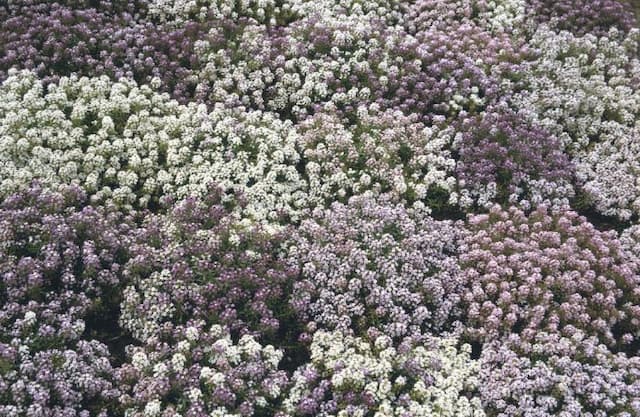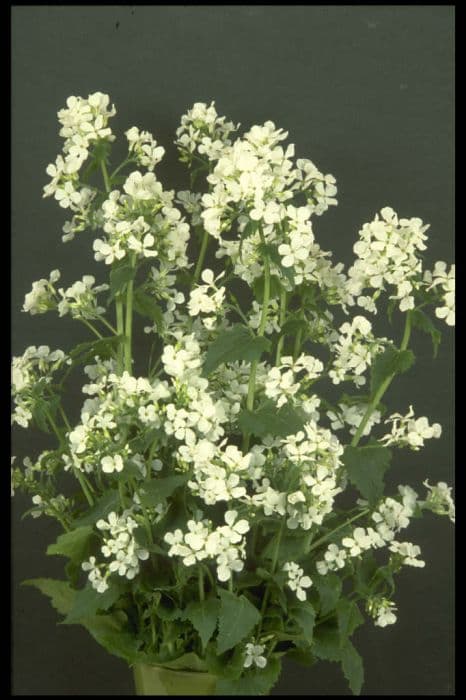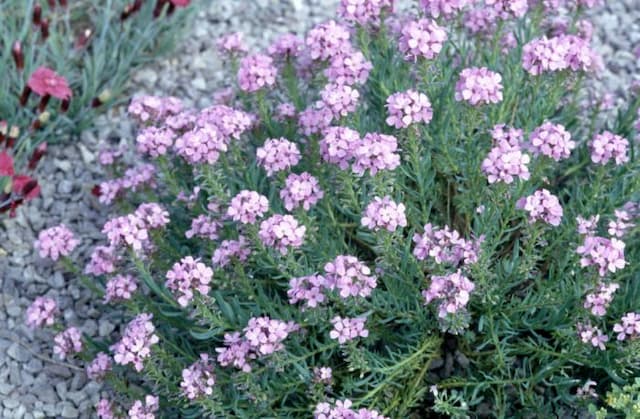Coast Rock Cress Arabis blepharophylla

ABOUT
Arabis blepharophylla, commonly known as coast rock cress, is a perennial plant known for its ornamental value in gardens. The appearance of coast rock cress is characterized by a rosette of dark green leaves at its base. These leaves are typically lobed or deeply cut, and can have a slightly hairy texture. As the plant matures, it produces stems which bear clusters of flowers. The flowers of coast rock cress are particularly notable for their vibrant colors. They are usually a deep, brilliant pink or occasionally a light pink, providing a striking contrast against the green foliage. Each flower consists of four small petals arranged in a cross shape, which is a common characteristic among plants in its family. Beneath the flowers and foliage, the plant forms a somewhat woody base, which helps support the above-ground structures. Over time, coast rock cress may spread out to create a denser appearance as it grows. This plant is often appreciated in garden settings for its bright floral display and its ability to create a lush ground cover without towering over other plants in the landscape.
About this plant
 Names
NamesSynonyms
Coast Rock Cress, Rose Rock Cress, Fringe Pod.
Common names
Arabis blepharophylla Hook. & Arn.
 Toxicity
ToxicityTo humans
Arabis blepharophylla, commonly known as coast rock cress, is not widely recognized as a toxic plant to humans. There is little information suggesting that this plant poses significant risks if ingested. However, as with many plants, it is possible that some individuals could experience mild gastrointestinal upset or allergic reactions if they consume parts of the plant without proper knowledge or identification. As with any wild or unknown plants, it is generally advisable to avoid ingestion to prevent any potential adverse effects.
To pets
Coast rock cress, the most common name for Arabis blepharophylla, does not have a well-documented toxicity profile for pets such as cats and dogs. It is not commonly listed among plants that are known to be poisonous to pets. However, as with any non-food plant, consumption of large quantities could potentially cause mild gastrointestinal discomfort, such as vomiting or diarrhea, due to the plant material irritating the stomach. If a pet ingests coast rock cress and shows signs of distress, it is advisable for the owner to consult a veterinarian.
 Characteristics
CharacteristicsLife cycle
Perennials
Foliage type
Evergreen
Color of leaves
Green
Flower color
Pink
Height
1 foot [30 cm]
Spread
1 foot [30 cm]
Plant type
Herb
Hardiness zones
8
Native area
California
Benefits
 General Benefits
General Benefits- Erosion Control: Arabis blepharophylla, commonly known as rock cress, has strong root systems that can help stabilize soil and prevent erosion on slopes.
- Pollinator Attraction: Rock cress produces flowers that attract beneficial pollinators like bees and butterflies, supporting local ecosystems.
- Aesthetic Appeal: With its vibrant pink or purple flowers, rock cress adds a splash of color to gardens and landscapes, enhancing visual interest.
- Drought Resistance: Once established, rock cress is quite drought-tolerant, making it a suitable choice for xeriscaping and water-wise gardens.
- Low Maintenance: Rock cress is easy to care for, requiring minimal upkeep, which makes it ideal for gardeners of all skill levels.
- Ground Cover: Rock cress spreads effectively, providing quick coverage, and can be used to suppress weeds in garden beds.
- Adaptability: Rock cress is hardy and can thrive in a variety of conditions, from full sun to partial shade and in rocky soils.
- Seasonal Interest: Its early bloom time in spring provides interest in the garden when many other plants are not yet in flower.
 Medical Properties
Medical PropertiesThis plant is not used for medical purposes.
 Air-purifying Qualities
Air-purifying QualitiesThis plant is not specifically known for air purifying qualities.
 Other Uses
Other Uses- Coast rock cress can be used as a natural dye source, where different parts of the plant can create subtle colorations on fabrics or yarns.
- The plant acts as a cushion in rock gardens or crevices, providing stability for soil and preventing erosion with its mat-forming growth habit.
- In ecological landscaping, coast rock cress serves as a nectar source to attract and sustain beneficial insects, especially bees and butterflies.
- With its low-growing and spreading characteristics, coast rock cress can be used as a living mulch that suppresses weeds and retains soil moisture.
- Its dense foliage provides habitat for small ground-dwelling creatures, creating microenvironments crucial for biodiversity within the garden.
- When used in container gardens, coast rock cress drapes over the edges, offering a cascading aesthetic and adding another layer of visual interest.
- The flower petals of coast rock cress can be used in culinary decoration, for example, sprinkled on salads or desserts to add a splash of color.
- In education, coast rock cress can be incorporated into botany lessons for students to learn about plant growth, reproduction, and adaptation in harsh conditions.
- The plant can serve as an indicator species for landscape health, as its presence and vigor in the wild can reflect the condition of the surrounding ecosystem.
- Due to its tolerance for poor, rocky soils, coast rock cress can be used in phytoremediation efforts to stabilize and rehabilitate disturbed lands.
Interesting Facts
 Feng Shui
Feng ShuiThe Coast Rock Cress is not used in Feng Shui practice.
 Zodiac Sign Compitability
Zodiac Sign CompitabilityThe Coast Rock Cress is not used in astrology practice.
 Plant Symbolism
Plant Symbolism- Resilience: Arabis blepharophylla, commonly known as coast rock cress, often grows in tough, rocky environments, symbolizing the ability to thrive in challenging conditions.
- Protection: The rugged nature of the coast rock cress may also symbolize protection, as it can survive in harsh coastal climates, offering a semblance of greenery and shelter amid the rocks.
- Beauty in Simplicity: With its simple yet vibrant flowers, coast rock cress can represent the idea that there is elegance and charm in simplicity, reminding us to appreciate the basic pleasures in life.
- Adaptability: Coast rock cress adapts well to various conditions, which can be seen as a representation of adaptability in life and the importance of being flexible in order to overcome obstacles.
 Water
WaterFor coast rock cress, watering should be thorough, allowing the soil to become moist but not waterlogged. It typically needs water every week, with approximately half a gallon for smaller plants and up to 1-2 gallons for larger, established plants depending on weather conditions and soil type. During hotter and drier periods, it may require water twice a week, whereas, in cooler, damp climates, less frequent watering is necessary. Ensure that the soil dries out slightly between watering to prevent root rot. Monitor the plant's response to your watering schedule and adjust as necessary to keep the soil consistently moist but not saturated.
 Light
LightCoast rock cress thrives best in full sun to partial shade. An ideal spot would provide bright sunlight for at least 6 hours a day but offer some protection from the intense afternoon sun, especially in hotter regions. Placing the plant in a location where morning sun is abundant will promote healthy growth and vibrant flowering.
 Temperature
TemperatureCoast rock cress prefers temperatures between 50°F and 75°F and will survive in climates where the temperature doesn't typically drop below 20°F or exceed 90°F. The plant enjoys cooler temperatures but can tolerate short periods of heat if properly watered. To ensure the best growth, keep the plant in a location that reflects its ideal temperature range throughout the year.
 Pruning
PruningPruning coast rock cress is essential to maintain its shape, encourage bushier growth, and enhance flowering. Light pruning can be done in early spring to remove any dead or damaged foliage and again after the blooming period to tidy the plant and stimulate another round of flowers. The best time for major pruning is late winter or early spring before new growth begins.
 Cleaning
CleaningAs needed
 Soil
SoilCoast Rock Cress prefers well-draining, sandy to loamy soil with a slightly acidic to neutral pH of 6.0 to 7.0. A mixture of two parts potting soil, one part perlite, and one part sand would create an ideal growing medium for this plant.
 Repotting
RepottingCoast Rock Cress should be repotted every two to three years to refresh the soil and to accommodate growth. Repot in spring or early summer when the plant is actively growing.
 Humidity & Misting
Humidity & MistingCoast Rock Cress thrives best in average humidity conditions. It does not require high humidity and will do well in typical household humidity levels.
 Suitable locations
Suitable locationsIndoor
Provide bright light, well-draining soil, and water sparingly.
Outdoor
Plant in well-draining soil with full sun to partial shade.
Hardiness zone
4-9 USDA.
 Life cycle
Life cycleCoast rock cress (Arabis blepharophylla) starts its life cycle from a seed which germinates in late winter or early spring, requiring cold stratification to break dormancy. Upon germination, it develops into a rosette of basal leaves, with deep green, hairy foliage that grows close to the ground. As temperatures warm, it enters the vegetative stage, during which the plant puts forth erect stems and additional leaves. The next stage is flowering, occurring in late spring to early summer, where the plant produces small, four-petaled, reddish-purple to pink flowers arranged in a raceme. After pollination, typically by insects, the flowers develop into siliques (seed pods), which mature and eventually release seeds when dry, completing the reproductive phase. The plant is a biennial or short-lived perennial and, after setting seed, individual plants may die back, although the species survives through the seeds which will go on to start the life cycle anew.
 Propogation
PropogationPropogation time
Spring to Summer
Arabis blepharophylla, commonly known as coast rock cress, is best propagated through the division of its clumps. The most suitable time to undertake this propagation method is in the cooler months of fall or early spring. To propagate by division, carefully lift the plant with a garden fork, ensuring you minimize root damage. Gently separate the clumps into smaller sections, making sure each division has a good amount of roots attached. Plant the divisions immediately into a well-prepared soil bed that is rich in organic matter, and water thoroughly. Space them approximately 8 to 12 inches (20 to 30 centimeters) apart to allow for adequate air circulation and growth expansion. This method ensures healthy new plants that will grow vigorously, often flowering in their first season after the division.

![Aubrieta [Axcent Lilac]](/_next/image?url=https%3A%2F%2Fplants-admin.emdemapps.com%2Fimages%2Fplants%2F%2Fimages%2F604b5e2430fac.png&w=640&q=75)







